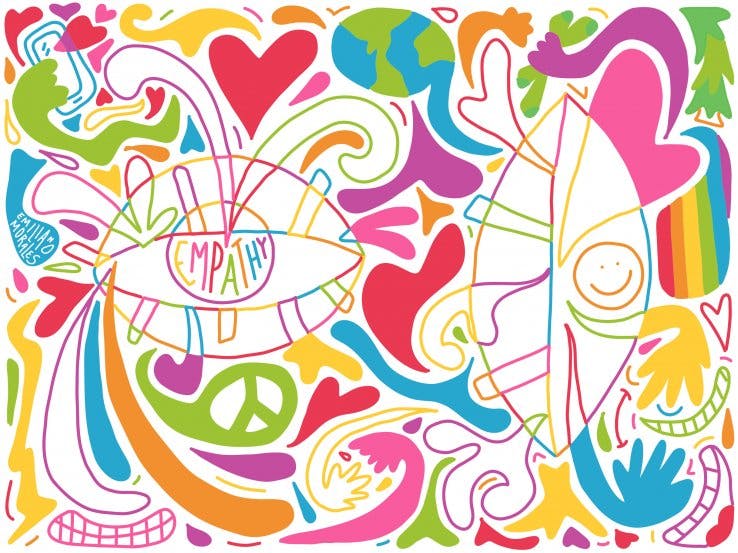
adinkra and its history
Adinkra is the only African cloth printing tradition of pre-Colonial origin. It is one of the prestigious royal crafts produced in villages around the Asante capital Kumase, in this case being almost entirely confined to the village of Ntonso. According to Asante legend it was introduced in 1818 following the capture of a rival monarch by the name of Adinkra, who wore the cloth to express his sorrow on being taken to Kumase. Adinkra involves the printing of designs in a black dye made from the bark of certain trees, using stamps carved from sections of calabash. The earliest examples in museum collections are printed on locally woven cloth, and this is still done today, but for most of the the twentieth century the use of imported cloth as a background has been more common. The plain cloth is pegged out on a flat piece of ground ready to be decorated. The artist begins by marking out the grid of lines using a device like a broad toothed comb. Once this is complete he fills in one square at a time, recharging the stamp in the dye each time before pressing it lightly onto the cloth. Sometimes two or more designs are alternated in a single square, more usually each square has a distinct motif. On older cloths the sections are usually joined by multicoloured cotton stitching.<br /><br />
<br /><br /><br />
<br /><br /><br />
<br /><br /><br />
<br /><br /><br />
<br /><br /><br />
<br /><br /><br />
<br /><br /><br />
<br /><br /><br />
<br /><br /><br />
<br /><br /><br />
<br /><br /><br />
<br /><br /><br />
<br /><br /><br />
<br /><br /><br />
<br /><br /><br />
<br /><br />
<br /><br /><br />
<br /><br /><br />
<br /><br /><br />
<br /><br /><br />
<br /><br /><br />
<br /><br /><br />
<br /><br /><br />
<br /><br /><br />
<br /><br /><br />
<br /><br /><br />
<br /><br /><br />
<br /><br /><br />
<br /><br /><br />
<br /><br /><br />
<br /><br /><br />
HOME ADINKRA GALLERY MAIN GALLERY <br /><br />
<br /><br /><br />
<br /><br /><br />
<br /><br /><br />
<br /><br /><br />
<br /><br /><br />
<br /><br /><br />
<br /><br /><br />
<br /><br /><br />
<br /><br /><br />
<br /><br /><br />
<br /><br /><br />
<br /><br /><br />
<br /><br /><br />
<br /><br /><br />
<br /><br /><br />
<br /><br />
<br /><br /><br />
<br /><br /><br />
<br /><br /><br />
<br /><br /><br />
<br /><br /><br />
<br /><br /><br />
<br /><br /><br />
<br /><br /><br />
<br /><br /><br />
<br /><br /><br />
<br /><br /><br />
<br /><br /><br />
<br /><br /><br />
<br /><br /><br />
<br /><br /><br />
<br /><br />
<br /><br /><br />
<br /><br /><br />
<br /><br /><br />
<br /><br /><br />
<br /><br /><br />
<br /><br /><br />
<br /><br /><br />
<br /><br /><br />
<br /><br /><br />
<br /><br /><br />
<br /><br /><br />
<br /><br /><br />
<br /><br /><br />
<br /><br /><br />
<br /><br /><br />
Adinkra is the only African cloth printing tradition of pre-Colonial origin. It is one of the prestigious royal crafts produced in villages around the Asante capital Kumase, in this case being almost entirely confined to the village of Ntonso. According to Asante legend it was introduced in 1818 following the capture of a rival monarch by the name of Adinkra, who wore the cloth to express his sorrow on being taken to Kumase. Adinkra involves the printing of designs in a black dye made from the bark of certain trees, using stamps carved from sections of calabash. The earliest examples in museum collections are printed on locally woven cloth, and this is still done today, but for most of the the twentieth century the use of imported cloth as a background has been more common. The plain cloth is pegged out on a flat piece of ground ready to be decorated. The artist begins by marking out the grid of lines using a device like a broad toothed comb. Once this is complete he fills in one square at a time, recharging the stamp in the dye each time before pressing it lightly onto the cloth. Sometimes two or more designs are alternated in a single square, more usually each square has a distinct motif. On older cloths the sections are usually joined by multicoloured cotton stitching.<br /><br />
<br /><br /><br />
<br /><br /><br />
<br /><br /><br />
<br /><br /><br />
<br /><br /><br />
<br /><br /><br />
<br /><br /><br />
<br /><br /><br />
<br /><br /><br />
<br /><br /><br />
<br /><br /><br />
<br /><br /><br />
<br /><br /><br />
<br /><br /><br />
<br /><br /><br />
<br /><br />
<br /><br /><br />
<br /><br /><br />
<br /><br /><br />
<br /><br /><br />
<br /><br /><br />
<br /><br /><br />
<br /><br /><br />
<br /><br /><br />
<br /><br /><br />
<br /><br /><br />
<br /><br /><br />
<br /><br /><br />
<br /><br /><br />
<br /><br /><br />
<br /><br /><br />
<br /><br />
<br /><br /><br />
<br /><br /><br />
<br /><br /><br />
<br /><br /><br />
<br /><br /><br />
<br /><br /><br />
<br /><br /><br />
<br /><br /><br />
<br /><br /><br />
<br /><br /><br />
<br /><br /><br />
<br /><br /><br />
<br /><br /><br />
<br /><br /><br />
<br /><br /><br />
An official of the court of the Asantehene, king of the Asante people of Ghana, wearing an old adinkra cloth, Kumasi 1997.(c) D.Clarke<br /><br />
<br /><br /><br />
<br /><br /><br />
<br /><br /><br />
<br /><br /><br />
<br /><br /><br />
<br /><br /><br />
<br /><br /><br />
<br /><br /><br />
<br /><br /><br />
<br /><br /><br />
<br /><br /><br />
<br /><br /><br />
<br /><br /><br />
<br /><br /><br />
<br /><br /><br />
<br /><br />
<br /><br /><br />
<br /><br /><br />
<br /><br /><br />
<br /><br /><br />
<br /><br /><br />
<br /><br /><br />
<br /><br /><br />
<br /><br /><br />
<br /><br /><br />
<br /><br /><br />
<br /><br /><br />
<br /><br /><br />
<br /><br /><br />
<br /><br /><br />
<br /><br /><br />
Proverbs play an important role in Asante culture, their use being a mark of wisdom and cultural knowledge. Like many other aspects of Asante art, many of the Adinkra stamp designs are named by reference to proverbs, while others have naturalistic referents.Nevertheless it doesn't seem that the cloth as a whole is intended to be "read" or decoded.The communicative import of the cloth was instead conveyed by the colour, with red, brown, and black cloths associated in the past with funerals and periods of mourning, while white cloths were worn for post-mourning celebrations and joyous occasions more generally. Today they have taken on a more general significance as an important and unique form of African textile artistry.
Ghana
MediumPhotography, Colour
Related Issues Culture












